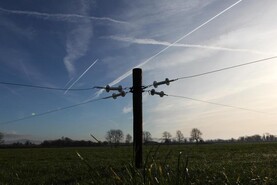The final segment of my eight-month professional work experience journey has led me to the green gates of Harp Renewables in Kentstown, Navan, Co Meath. Harp began life as an electrical engineering company specialising in manufacturing and installation in the waste and recycling industries across Ireland and the UK. On the back of this experience, the company extended into the renewable energy sector, creating Harp Renewables.
The final segment of my eight-month professional work experience journey has led me to the green gates of Harp Renewables in Kentstown, Navan, Co Meath.
Harp began life as an electrical engineering company specialising in manufacturing and installation in the waste and recycling industries across Ireland and the UK. On the back of this experience, the company extended into the renewable energy sector, creating Harp Renewables.
The company offers a wide range of services in the renewables sector including biomass applications, BioNova organic waste digesters and the production of biogas using anaerobic digestion in partnership with Green Gas UK Ltd. My placement work has been primarily focused on the anaerobic digestion segment of Harp Renewables working in both Ireland and at various established sites across the UK.
Biomass applications
Biomass is biological material derived from living, or recently living organisms. It refers particularly to plants or plant-based materials which are specifically called lignocellulosic biomass.
Wood remains the largest biomass energy source. Wood-based biomass comes in various forms, with the two most prevalent in Ireland and the UK being woodchip and pellets.
In the UK, biomass applications may also attract a government-funded non-domestic renewable heat incentive
Harp Renewables supplies both woodchip and pellet systems using a twin-heat biomass boiler. There are a number of benefits businesses and individuals can gain from biomass installations such as reduced heating expense in comparison to oil or gas, green status credentials achieved by the business, realistic and achievable commercial paybacks as well as reducing CO2 emissions into the environment.
In the UK, biomass applications may also attract a government-funded non-domestic renewable heat incentive.
BioNova organic waste digesters
Harp Renewables also develops and installs organic waste digesters for industrial use. The technology used has the ability to turn raw organic waste into a dry combustible material within 24 hours. According to the volume of food waste accumulated, its C2, C5 and C20 continuous aerobic digestion products are sized to cater for a variety of organic wastes.

A notable example is the installation of a C5 BioNova digester in Mermaid Quay in Cardiff, Wales. It is located less than 1km from the city centre, and a number of bars, restaurants and cafes dotted throughout Mermaid Quay use the digester as their food waste disposal option.
The key attraction of this waste digester is that it reduces transport and disposal costs for these businesses, but research is also being carried out by Harp Renewables into the potential use of this biomass as a biofuel and/or a soil enhancer for agricultural purposes.
Following the adoption of this approach to recycling, Mermaid Quay became a finalist in the waste management category of the National Recycling Awards in the UK in 2016.
Anaerobic digesters
As a student of agricultural science, the area of anaerobic digestion is the facet of Harp Renewables that interests me most. Anaerobic digestion has huge potential in Ireland and the UK. The concept of turning a byproduct of farming into a commodity creates phenomenal potential to add a new income stream for the sector.
The primary feedstock for anaerobic digestion is farmyard manure or slurry, but energy crops such as grass silage, whole-crop wheat, maize silage, fodder beet and many more can also increase biogas yield in the form of methane, boost electricity output and result in economic return for the investment.

In places like Germany and Poland, where anaerobic digesters are a common feature of the landscape, most installations are single-stage digesters. This means that gas is produced in a single tank.
Three anaerobic digestion systems have been established in the UK by Harp Renewables, with many more in the UK and Ireland forecast for the near future. All anaerobic digesters operating so far use a two-stage digestion process, where chemical reactions occur in different tanks. This reduces the digestate retention time, improves efficiency and enhances overall biogas and electricity yields.
Over the coming weeks, I hope to learn how Harp Renewables’ biomass solutions, organic waste digesters and anaerobic digestion systems can provide a viable, efficient and sustainable energy alternative to farmers, industries and agriculture at large.
James Meade is an agricultural science student at UCD and travels on the professional work experience programme supported by the Irish Farmers Journal and the Agricultural Science Association.
Read more
Read more student blogs
Read more from James Meade





SHARING OPTIONS: